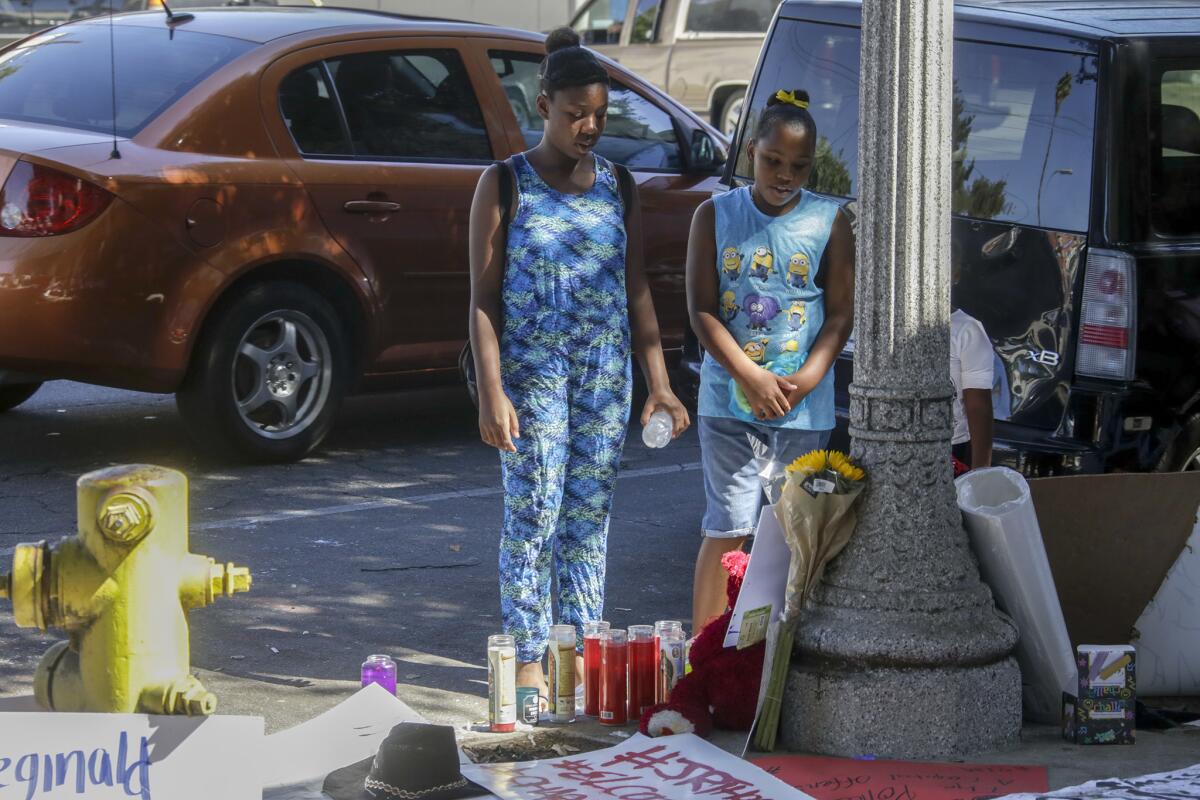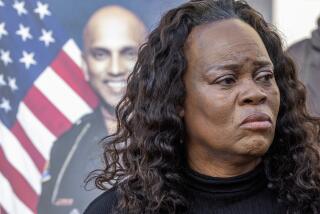After African American man is killed by police, Pasadena grapples with race, history and progress

- Share via
Reginald Thomas’ family gave him a nickname: Daddy Daycare.
He doted on his eight children, ages 3 to 11, and he couldn’t wait to meet his baby boy due in a few months. He loved to give advice and, despite struggles with mental illness, managed to stay positive, his family said.
On Saturday in Pasadena, people gathered at a small memorial to Thomas, who was killed by police in an altercation that sparked protests and questions.
Thomas’ death Friday had added to the national debate amid several recent high-profile deaths of black people at the hands of police, including the fatal shooting Tuesday of an unarmed black man in El Cajon. And Pasadena has dealt with its own racial tensions over police force against blacks, most notably the controversial killing in 2012 of Kendrec McDade.

Grainy security footage shows parts of a confrontation between Reginald Thomas Jr. and Pasadena police officers on Sept. 30. Thomas died after officers shocked him with a stun gun.
Pasadena police said Thomas was holding a knife in one hand and a fire extinguisher in the other and that officers stunned him after he ignored commands to drop either item. Thomas eventually went into distress, police said, and stopped breathing. Late Friday, police released 911 calls and surveillance tape that showed part of the altercation.
During one of several 911 calls placed before the incident, the caller — who appears to be Thomas’ brother, although police didn’t identify him because he’s a juvenile — says that he believes Thomas is high on drugs and has a knife tucked under his armpit.
“He hasn’t threatened any of you guys with the knife yet?” the operator asks.
“Not yet,” the caller responds.
“OK, is he known to be violent toward you guys?” she asks.
“Mmmhmm,” he responds.
Some community activists said Thomas’ death appears to fit a pattern in the way police deal with African Americans.
“Oh my goodness gracious, here we go again,” said Martin Gordon, an activist with the Pasadena Community Coalition. “Whether it’s a shooting or a Tasing, the bottom line is that African American men are dying.”
But Pasadena Mayor Terry Tornek said he hopes the public won’t rush to comparisons.
“It’s sort of unfair to lump all of these together,” he said of the larger narrative of police killings across the country. “I would just ask people to be patient.”
Tornek said he can understand the concerns of protesters but said the department has been working at improving its tactics and training in recent years.
“We’ll continue to do the quiet work we do to make sure people are treated fairly,” he said. “We’re trying to do our best to make sure these incidents don’t escalate and end in fatality. It’s very upsetting.”
In recent months, many police agencies across the country have initially opted not to release audio and video of fatal police encounters, but ultimately caved in to public pressure. But as hundreds of demonstrators marched through the streets of Pasadena to protest Thomas’ death Friday night, Pasadena police decided to release security video and audio from a 911 call.
Because Pasadena police don’t yet wear body cameras, officials said the only footage available is from a courtyard camera in the apartment complex where officials confronted Thomas. The night-time footage shows several officers running toward an apartment door as other officers engage in some type of struggle.
At a news conference Friday night, police Chief Phillip Sanchez said he’d noticed that video footage “has been a flash point” across the country.
“If that effort reduces the likelihood of one of my officers being injured or assaulted….or it safeguards my public...then I think it’s the prudent thing to do in this instance,” he said.
The information that was released, a sheriff’s official said, is “only a portion of the full investigation that’s underway.”
Gordon, the activist, said it’s important to look at Thomas’ death in the larger context of Pasadena’s long racial history.
Pasadena’s public swimming pool remained segregated until 1947 — the same year Jackie Robinson, who grew up in Pasadena, broke baseball’s color line.
Writing of his childhood, Robinson, whose family moved to town from Georgia, said they were treated like “intruders” in Pasadena. It was a place, he wrote, of racial slurs, movie theaters with segregated balconies and slammed doors at restaurants.
“In certain respects,” Robinson wrote, “Pasadenans were less understanding than Southerners and even more hostile.”
A city-commissioned study from earlier this year, found that many people of color in Pasadena — a city of roughly 140,000 where African Americans make up 11% of the population — reported feeling “under siege in their neighborhoods” and alienated from police.
Longtime Pasadena resident Paul Gibson, 70, said although there’s a history of distrust between Pasadena police and the city’s black community, he’s noticed police are taking steps to heal the divide.
The chief holds monthly meetings with clergy and community leaders, and Gibson said he noticed that police gave some space to demonstrators who gathered Friday evening.
“I’m really proud,” he said, “of the way police allowed protesters to grieve the loss of Mr. Thomas.”
Some of the changes came about in the wake of the police killing of McDade, 19, who was shot seven times after a 911 caller falsely reported that the Azusa High graduate was carrying a gun when he and a friend stole a laptop. The caller eventually pleaded guilty to falsely reporting a criminal offense, and the district attorney’s office cleared Officers Jeff Newlen and Matthew Griffin of wrongdoing in the shooting.
A later independent report found that Pasadena police failed during their investigation to determine whether witnesses could corroborate or refute the officers’ claims that McDade had been clutching at his waistband as he fled from their squad car.
That report also faulted the department for not conducting a separate internal affairs investigation into the tactics used by the officers, for waiting 36 hours before interviewing them and for providing the pair with video recordings of the aftermath of the shooting before their interviews — an action that “is likely to distort pure recall either consciously or subconsciously,” the report said.
On Saturday at the memorial for Thomas, some family and friends said they were still seeking answers.
One family friend knelt to pray near the memorial, while another arrived with flowers. A note scrawled in children’s handwriting with purple paint read, “My dad was a good father.”
When Thomas’ wife, Shainie Lindsay, arrived, a man handed her a $100 bill and gave her hug. Asked about her loss, Lindsay could only muster a couple words.
“Hurt,” she said. “Upset.”
Twitter: @AngelJennings
Twitter: @marisagerber
More to Read
Sign up for Essential California
The most important California stories and recommendations in your inbox every morning.
You may occasionally receive promotional content from the Los Angeles Times.












